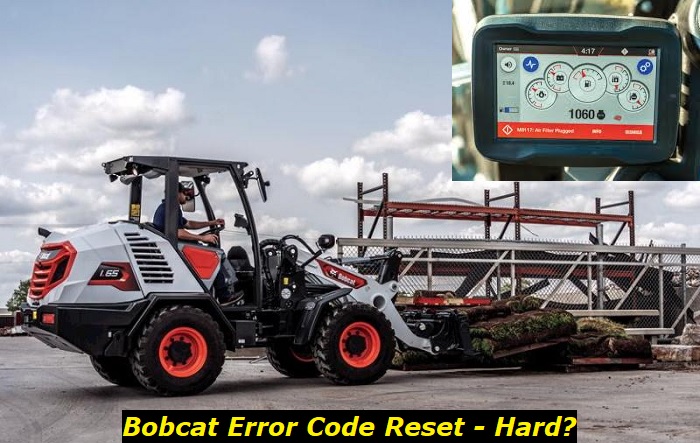How to Reset Bobcat Code? Our Guide and Recommendations
Codes appearing on your Bobcat can mean a lot of things. They can range from a minor glitch that will only cause a little nuisance as you operate your vehicle up to alarming warnings that point to possible parts failure.
The former will surely distract you in the way that you handle your job or operate your vehicle while the latter will potentially burn your budget from repairs and you will certainly get a major downtime that can lead to missed deadlines in your project. All of which can translate to productivity and opportunity losses for you.
In this article, we will tackle an important topic regarding the methods of resetting codes in your Bobcat as they occur for you to immediately know whether or not there is a serious matter in it that needs your immediate attention.

The Importance of Knowing and Addressing Codes in Your Bobcat Right Away
It is important to diagnose codes in your Bobcat right away as they can indicate problems that could lead to major headaches. For instance, certain codes may signal something as straightforward as a lack of fuel, oil, or fluids while others may indicate more critical issues such as a fault in an engine part or overheating.
If these types of problems are ignored and left unchecked, they could lead to serious damage to your Bobcat vehicle's components resulting in costly repairs. Not only that, but you may also experience significant downtime while the repair is being made, which will certainly mean a significant loss in your productivity as an owner or operator.
Restarting the Engine
Resetting codes in your Bobcat can be done in various ways depending on the severity of the problem you are facing. Sometimes, it is as easy as restarting your engine and the issue is suddenly gone.
This works if the code is simply triggered by nothing more than a minor hiccup in your vehicle's analog or digital control. It could also be due to a slight glitch in the components within the electrical system of your auto. However, if the code persists or is a recurring matter, then there could be more trouble brewing in your Bobcat.
Resetting Via the Instrument Panel
Hearing a beeping sound as you restart the engine of your Bobcat coupled with numbers indicating hours and the word "Ser" in the analog display of your vehicle's instrument panel means it is already due for maintenance. By default, it activates when your vehicle is already past its 250-hour maintenance schedule. This may also cause related faults to trigger in your equipment's electrical system.
Normally, the 250-hour maintenance schedule is the time when the filters, fluids, and other faulty or fouled components of your Bobcat have to be checked, serviced, or replaced. The amount of work that needs to be done depends on the type, model, age, and other factors associated with your vehicle, so there could be more to these.
Nonetheless, the servicing already includes resetting the code that you are seeing on the instrument panel of your machine. Naturally, this is the best course of action and is something that we highly recommend. On the other hand, if by chance you are running on a tight deadline with your project and you think that the servicing of your Bobcat can still be pushed to a later date, then all you have to do is reset its maintenance clock.
To do this, make sure that the engine of your Bobcat is not running by turning the key in the ignition to "Off". Follow it up by turning the "Lights" button on the instrument panel of your vehicle. This will once again trigger the beeping sound and the alert reminding you of its need for maintenance.
Next, press the High Flow and the Auxiliary buttons simultaneously. Keep the buttons pressed until the analog display reads "rESEt". This should reset the maintenance clock of your Bobcat and prevent the beeping sound and other codes related to its scheduled servicing from activating. Do note though that the warning, as well as the codes, will come out again when the timer for the servicing of your vehicle reaches 250 hours or the time that you have set (if you decided to manually alter it).
To make sure that your Bobcat is running properly and to prevent any issues from arising, it is always best to have it serviced as soon as possible. Even a minor delay may expose your vehicle closer to risks of possible parts failure that may hamper your productivity, put more dent in your budget, or cause safety hazards in your workplace.
Battery Reset
Another old-school way of taking care of codes in a vehicle is via a battery reset while the engine is off. Surprisingly, this still works wonders up to this day, so this is something that you should try before proceeding further.
The battery is commonly concealed within the back panel of a Bobcat vehicle within the engine bay. In most models, you may have to remove the brackets holding the battery in place to gain better access to its terminals. However, if you think you can do this without removing the brackets or pulling the battery out a bit, then proceed by removing the negative (-) cable from the terminal.
Wait for at least 15 minutes, but not more than 30 minutes, before reconnecting the cable to its terminal and putting the battery together with its brackets back. The next time you start your engine, those pesky codes will likely be gone.
Resetting Using a Diagnostic Kit or Scan Tool
One of the best ways to clear out Diagnostic Trouble Codes (DTCs) that seem to pop out in your vehicle for no possible reason and without signs of potential parts failure is through the use of a diagnostic kit or scan tool.
The process to do this varies on the kind of kit or tool you are using and the model or type of your Bobcat. However, do make sure to check the part or area covered by the code first before proceeding to confirm that everything is in order prior to clearing the DTC you are getting. Clearing the DTC will only serve as a temporary fix and you will likely get the same code again if parts are obviously failing in your unit.
With these in mind, refer to the service manual of your vehicle to locate its diagnostic connection before anything else. Keep in mind that the 2014 or newer models of Bobcats now come with two major diagnostic connections. One is for evaluating machine issues and the other is more specific to engine troubles.
From here, plug the device with the diagnostic kit or the scan tool in the connector corresponding to where the DTC is supposedly originating. Make sure that the electrical system of your Bobcat is powered on but see to it that its engine is off.
Most scan tools will initiate upon getting adequate power from the port. Some may require manually turning them on. At this point, refer to the manual that comes with the product or follow the prompts that will pop up on the display of your diagnostic tool to go through the resetting process. Most new ones should come with a step-by-step prompt that will walk you through the procedure to ensure that you can follow along and complete the task successfully.
ECU Reset
Last but not least is via an engine control unit (ECU) reset. Although many diagnostic tools come with this feature, we rather advise having a certified Bobcat technician help you out during this method. That's because tinkering with the ECU of your Bobcat may cause more problems along the way if not done properly, especially if you have accidentally or intentionally altered some of the preset configurations set by its manufacturer with regard to the operation of its crucial components.
Most DTCs can be fixed via the process of ECU reflashing. This is where the system of your auto is patched up with the recommended calibration values set by Bobcat to clear out possible glitches within and ensure the optimal performance of its various components.
Reminder
Remember that the methods shown here will only be effective if the code you are getting in your vehicle is only limited to glitches in its system. These should not serve as an alternative way of addressing parts that are already failing due to contamination, wear, damage, or other reasons.
Therefore, if you notice symptoms that clearly point to malfunctioning or failing parts, or the problems persist after you have exhaustively tried all the possible solutions here, do not hesitate to bring your Bobcat to its authorized service center or your trusted mechanic for further diagnosis, repairs, or parts replacement.
Conclusion
By diagnosing codes on your Bobcat immediately and addressing any potential issues, you can avoid large repair bills and costly downtime. That is why it is so important to take any diagnostic codes seriously and seek out professional assistance as soon as they appear on your Bobcat's dashboard. With a quick reaction, the problem can be resolved quickly and you can get back to work without disruption.
Don't ignore the warnings as they serve an important purpose in helping keep your Bobcat running smoothly. Act without delay and ensure that your Bobcat vehicle continues to provide reliable service for years to come.

Add comment